Total number of deaths 5,748 | ||
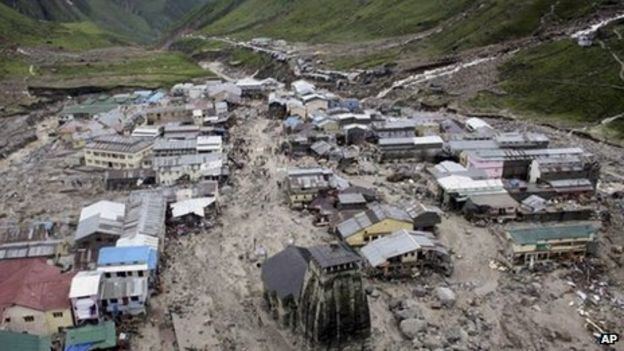 | ||
Property damage 4,200 villages were affected Similar 2013 Alberta floods, 2014 India–Pakistan floods, 2015 South Indian floods, Floods in Bihar, 2010 Pakistan floods | ||
In June 2013, a multi-day cloudburst centered on the North Indian state of Uttarakhand caused devastating floods and landslides becoming the country's worst natural disaster since the 2004 tsunami. The reason the floods occurred was that the rainfall recivied was on a larger scale than the regular rainfall the state usually received . The debris blocked up the rivers, causing major overflow. The main day of the flood is said to be on 16 June 2013. Though some parts of Himachal Pradesh, Haryana, Delhi and Uttar Pradesh in India experienced the flood, some regions of Western Nepal, and some parts of Western Tibet also experienced heavy rainfall, over 89 % of the casualties occurred in Uttarakhand. As of 16 July 2013, according to figures provided by the Uttarakhand government, more than 5,700 people were "presumed dead." This total included 934 local residents.
Contents
- Origin
- Consequences
- National Capital Region
- Uttar Pradesh
- Himachal Pradesh
- Nepal
- Rescue operations
- Aftermath
- Climate and environmental factors
- In fiction
- References
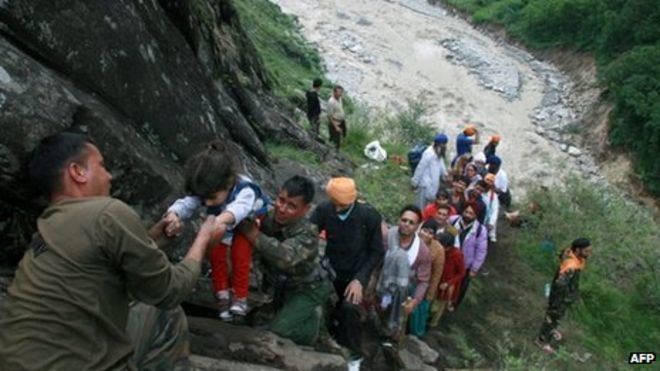
Destruction of bridges and roads left about 100,000 pilgrims and tourists trapped in the valleys leading to three of the four Hindu Chota Char Dham pilgrimage sites. The Indian Air Force, the Indian Army, and paramilitary troops evacuated more than 110,000 people from the flood ravaged area.
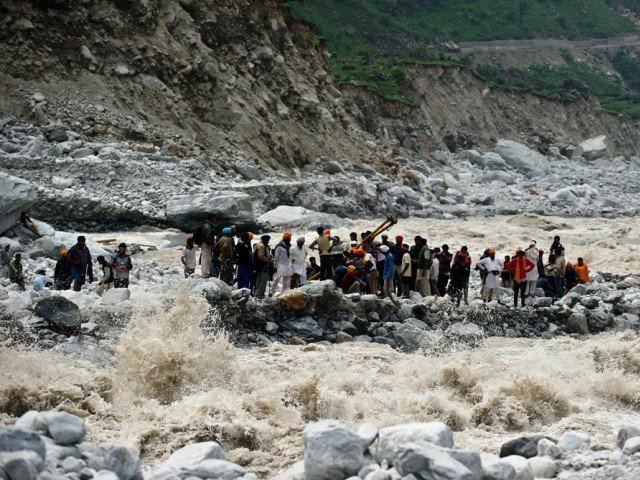
Origin
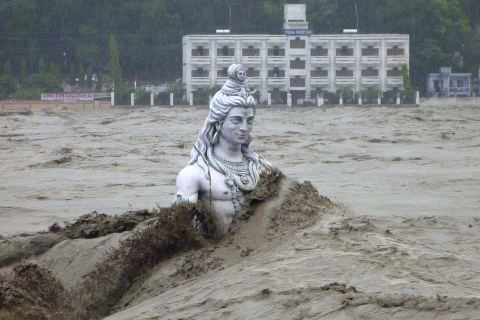
From 14 to 17 June 2013, the Indian state of Uttarakhand and adjoining areas received heavy rainfall, which was about 375% more than the benchmark rainfall during a normal monsoon. This caused the melting of Chorabari Glacier at the height of 3800 metres, and eruption of the Mandakini River which led to heavy floods near Gobindghat, Kedar Dome, Rudraprayag district, Uttarakhand, Himachal Pradesh and Western Nepal, and acute rainfall in other nearby regions of Delhi, Haryana, Uttar Pradesh and some parts of Tibet.
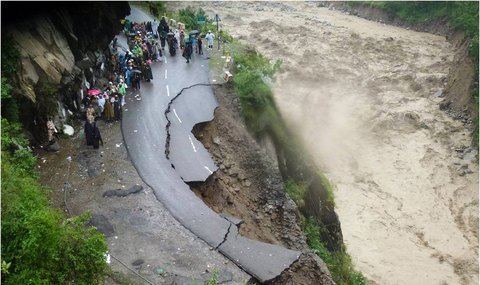
The upper Himalayan territories of Himachal Pradesh and Uttarakhand are full of forests and snow-covered mountains and thus remain relatively inaccessible. They are home to several major and historic Hindu and Sikh pilgrimage sites besides several tourist spots and trekking trails. Heavy rainfall for four consecutive days as well as melting snow aggravated the floods. Warnings by the India Meteorological Department predicting heavy rains were not given wide publicity beforehand, causing thousands of people to be caught unaware, resulting in huge loss of life and property.
Consequences
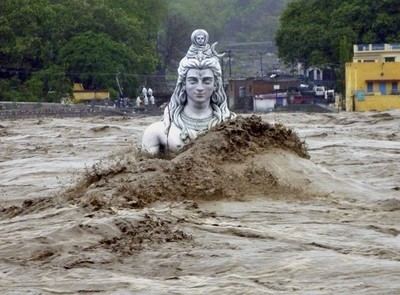
Landslides, due to the floods, damaged several houses and structures, killing those who were trapped. The heavy rains resulted in large flashfloods and massive landslides. Entire villages and settlements such as Gaurikund and the market town of Ram Bada, a transition point to Kedarnath, have been obliterated, while the market town of Sonprayag suffered heavy damage and loss of lives. Pilgrimage centres in the region, including Gangotri, Yamunotri, Kedarnath and Badrinath, the hallowed Hindu Chardham (four sites) pilgrimage centers, are visited by thousands of devotees, especially after the month of July onwards. Over 70,000 people were stuck in various regions because of damaged or blocked roads. People in other important locations like the Valley of flowers, Roopkund and the Sikh pilgrimage centre Hemkund were stranded for more than three days. National Highway 58, an important artery connecting the region was also washed away near Jyotirmath and in many other places. Because summers have more number of tourists, the number of people impacted is substantial. For more than three days, stranded pilgrims and tourists were without rations or survived on little food. The roads were seriously damaged at more than 450 places, resulting in huge traffic jams, and the floods caused many cars and other vehicles to be washed away. On 18 June, more than 12,000 pilgrims were stranded at Badrinath, the popular pilgrimage center located on the banks of the Alaknanda River. Rescuers at the Hindu pilgrimage town of Haridwar on the river Ganga recovered bodies of 40 victims washed down by the flooded rivers as of 21 June 2013. Bodies of people washed away in Uttarakhand were found in distant places like Bijnor, Allahabad and Bulandshahr in Uttar Pradesh. Searching for bodies who died during the extreme natural fury of June in Kedar valley continued for several months and even as late as September, 2013, about 556 bodies were found out of which 166 bodies were found in highly decomposed state during fourth round of search operations.
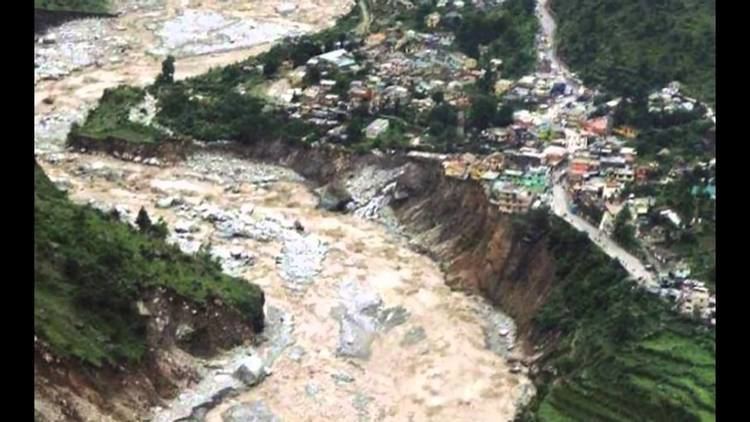
Although the Kedarnath Temple itself was not damaged, its base was inundated with water, mud and boulders from the landslide, damaging its perimeter. Many hotels, rest houses and shops around the temple in Kedarnath township were destroyed, resulting in several casualties. Most of the destruction at Kedarnath was caused by a sudden rapid melting of ice and snow on the Kedarnath Mountain, 6 km (3.7 mi) from the temple, which flooded the Charbari lake (upstream) and then Kedarnath. The temple was flooded with water resulting in several deaths due to drowning and panic-driven stampede. Even after a week, dead bodies had not been removed from Kedarnath town, resulting in water contamination in the Kedarnath valley and villagers who depend on spring water suffered various types of health problems like fever, diarrhoea. When the flood receded, satellite images showed one new stream at Kedarnath town. No damage at the Kedarnath Temple occurred. The Uttarakhand Government announced that due to the extensive damage to the infrastructure, the temple will be temporarily closed to regular pilgrims and tourists for a year or two, but the temple rituals will still be maintained by priests. The Temple opened for pilgrims on Sunday, 4 May 2014.
National Capital Region
New Delhi, Gurgaon and surrounding areas received a high amount of rainfall on 16 June 2013, leading to flooding of the low-lying areas of the cities. The Yamuna River swelled to a new high of 207.75 meters submerging the low lying flood plains along the banks.
Uttar Pradesh
Six-hundred and eight villages, covering a population of 700,000, in 23 districts of Uttar Pradesh were affected by the flood and drought. As of 11 July 2013 more than 120 deaths were reported from the state.
Himachal Pradesh
In Himachal Pradesh, floods caused loss of life and property and death toll in the state was 20.
Nepal
About 6000 citizens of Nepal were visiting the Indian region, of which 1,000 were rescued as of 22 June 2013. Flooding of the Dhauliganga and the Mahakali rivers had caused extensive damage, with reports of 128 houses and 13 government offices swept away and over 1000 people homeless. A bridge that joins the India-Nepal border is highly damaged or destroyed.
Rescue operations
The Army, Air Force, Navy, Indo-Tibetan Border Police (ITBP), Border Security Force, National Disaster Response Force (NDRF), Public Works Department and local administrations worked together for quick rescue operations. Several thousand soldiers were deployed for the rescue missions. Activists of political and social organisations were also involved in the rescue and management of relief centres. The national highway and other important roads were closed to regular traffic. Helicopters were used to rescue people, but due to the rough terrain, heavy fog and rainfall, manoeuvring them was a challenge. By 21 June 2013, the Army had deployed 10,000 soldiers and 11 helicopters, the Navy had sent 45 naval divers, and the Air force had deployed 43 aircraft including 36 helicopters. From 17 to 30 June 2013, the IAF airlifted a total of 18,424 people - flying a total of 2,137 sorties and dropping/landing a total of 3,36,930 kg of relief material and equipment.
On 25 June, one of 3 IAF Mil Mi-17 rescue helicopters returning from Kedarnath, carrying 5 Air Force Officers, 9 of the NDRF, and 6 of the ITBP crashed on a mountainous slope near Gauri Kund, killing all on board. The deceased soldiers were given a ceremonial Guard of honour by Home minister of India, at a function organised by the Uttarakhand State Government.
Indo Tibetan border Police (ITBP) a Force which guards the Indo China borders on the high himalayas with its 3 Regional Response Centres (RRCs) based at Matli (Uttarkashi), Gauchar (Chamoli) and Pithoragarh swung into action and started rescue and relief operation. 2000 strong ITBP force with its mountaineering skills and improvisation methods started rescue of stranded pilgrims. It was a simultaneous effort by ITBP at Kedar ghati, Gangotri valley and Govind ghat areas. According to official figures by ITBP, they were able to rescue 33,009 pilgrims in 15 days on their own from extreme remote and inaccessible areas.Before Army or Air Force called in, being deployed in the nearby areas, ITBP took the first call and saved many lives. They also distributed food packets to stranded pilgrims who were in a pathetic condition being not having any food for more than 72 hours at many places.
Aftermath
The Prime Minister of India undertook an aerial survey of the affected areas and announced₹10 billion (US$150 million) aid package for disaster relief efforts in the state. Several state governments announced financial assistance, with Uttar Pradesh pledging ₹250 million (US$3.7 million), the governments of Haryana, Maharashtra and Delhi ₹100 million (US$1.5 million) each, the governments of Tamil Nadu, Odisha, Gujarat, Madhya Pradesh and Chhattisgarh ₹50 million (US$740,000) each. The US Ambassador to India extended a financial help of USD $150,000 through the United States Agency for International Development (USAID) to the NGOs working in the area. and announced that the US will provide further financial aid of USD $75,000.
The Government of India also cancelled 9 batches, or half the annual batches of the Kailash-Mansarovar Yatra, a Hindu pilgrimage. The Chardham Yatra pilgrimage, covering Gangotri, Yamunotri, Kedarnath and Badrinath was cancelled for 2 years to repair damaged roads and infrastructure, according to the Uttarakhand Government.
Government agencies and priests of Kedarnath temple were planning mass cremation of the hundreds of victims, after one week of tragedy. Local youths from several affected villages near Gangotri helped stranded tourists and pilgrims, by sending messages to their places and by providing food. Rescuers also retrieved approximately ₹10 million (US$150,000) and other jewellery from local persons, including some people dressed like sadhu babas, who reportedly collected it from a destroyed building of a Bank and damaged shops.
Climate and environmental factors
A study by Utah State University analyzed the natural and anthropogenic influences on the climate anomalies using simulations, and found that (a) northern India has experienced increasingly large rainfall in June since the late 1980s, (b) the increase in rainfall appears to be associated with a tendency in the upper troposphere towards amplified short waves, and (c) the phasing of such amplified short waves is tied to increased loading of green-house gases and aerosols. In addition, a regional modeling diagnosis attributed 60–90 % of rainfall amounts in the June 2013 event to post-1980 climate trends.
Unprecedented destruction by the rainfall witnessed in Uttarakhand state was also attributed, by environmentalists, to unscientific developmental activities undertaken in recent decades contributing to high level of loss of property and lives. Roads constructed in haphazard style, new resorts and hotels built on fragile river banks and more than 70 hydroelectric projects in the watersheds of the state led to a "disaster waiting to happen" as termed by certain environmentalists. The environmental experts reported that the tunnels built and blasts undertaken for the 70 hydro electric projects contributed to the ecological imbalance in the state, with flows of river water restricted and the streamside development activity contributing to a higher number of landslides and more flooding.
In fiction
A novel titled A Long Journey was written and published by independent author Pawan Kumar Pandey, which has the floods and the resulting tragedy in its background.
